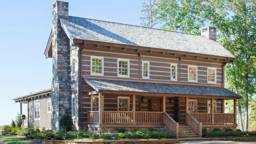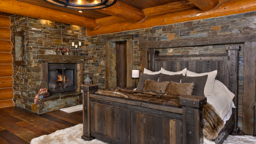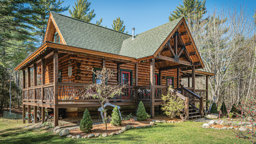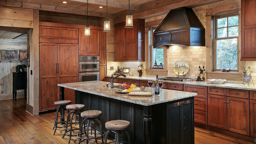Full-log house, or log home hybrid? What are the advantages to building a hybrid?
When David Stubbs and Terry Matre approached Maple Island Log Homes with their ideas for a 10,000-square-foot home they could use as a bed-and-breakfast, designer Ed Kriskywicz was open to their ideas. “I knew the house would be wonderful,” he recalls. “However, a few others at the company were not quite as excited as myself. I’d say they felt cautious. With the Stubbs-Matre residence being our first log hybrid design, Maple Island wanted to be sure that we covered all concerns and unknowns, not only during construction at our log yard, but also for years to come after the construction phase was completed. We didn’t want any callbacks. From design to building to maintenance, we sat down and established worst-case scenarios so we could solve each potential problem we might be presented with.” “Actually,” company owner David Tuxbury clarifies, “Maple Island had done numerous other log hybrid designs and buildings. It’s just that when we did them, there wasn’t an official term for them, like there is now.”
 The exterior of David Stubbs' and Terry Matre's log home hybrid bed & breakfast. Hybrids mix log and conventional construction. Roger Wade photo
The exterior of David Stubbs' and Terry Matre's log home hybrid bed & breakfast. Hybrids mix log and conventional construction. Roger Wade photo
Other times, “hybrid” might mean a stacked-log home that features timber-framing aspects inside. Tuxbury has been handcrafting log homes for more than 35 years. “One project that I recall quite well, from about 10 years ago, involved the use of logs for floor joists, tie logs, trusses and accents inside a traditional framed house,” he says. “It was beautiful when completed.” Even though Maple Island’s specialty is full-log homes, Kriskywicz and Tuxbury agree that having more than a single construction style enables them to offer more options to capture a larger share of the new-home market. “There are definitely some monetary advantages to clients considering a log home hybrid, which cost less than a handcrafted, full-log home,” Tuxbury says. “But an added benefit is the flexibility in design options. Some very interesting design elements can be produced. We hope to do more of this type of home and feel it is gaining in popularity.”
Acknowledging the consumer-driven log hybrid trend, dozens of log-home companies, both manufacturers and handcrafters, have produced homes that modify the log components. And now that these homes have a name, Maple Island Log Homes has even added a “hybrid” section to its website. “I have also designed a handful of stock plans to help potential clients see what we can do,” Kriskywicz says, but adds, “This particular log hybrid design was definitely driven by the homeowners. David and Terry knew what they wanted and worked with us very closely to devise the plan.”





_11868_2023-12-20_08-12-256x288.jpg)





